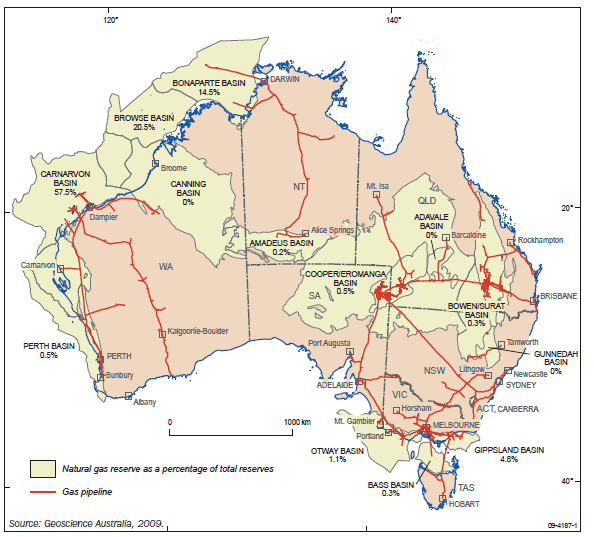RESOURCES
Australia has large identified resources of fossil fuels and uranium. It is ranked in the top six countries in the world for economic demonstrated resources (EDR) of black and brown coal, and has the world's largest EDR of uranium. Australia also has significant reserves of natural gas and crude oil. For a more detailed outline on Australia's energy and mineral resources, see the Mining chapter.
Australia has substantial resources of high quality black coal. At June 2009, the EDR of black coal totalled 1,103,751 petajoules (PJ), with most of these resources located in New South Wales and Queensland. Small but locally important black coal resources occur in Western Australia, South Australia and Tasmania. Brown coal occurs mainly in Victoria with other deposits in Western Australia, South Australia and Tasmania.
Map 19.1 shows the extent of access to gas resources and major transmission pipelines in Australia. At June 2009, the EDR of natural gas totalled 133,940 PJ (table 19.2), with the Carnarvon Basin accounting for over 50% of total reserves. The total length of Australia's natural gas transmission pipeline system has increased from 9,000 kilometres (km) in 1989 to almost 26,000km in 2007. The natural gas distribution network reaches 3.9 million customers.
19.1 Gas reserves and pipelines - January 2009

In the period 1999-2009 the EDR of black coal, brown coal, crude oil and liquified petroleum gas (LPG) each decreased, while the EDR of natural gas and uranium each rose (table 19.2).
19.2 ECONOMIC DEMONSTRATED RESOURCES OF PRIMARY ENERGY PRODUCTS - 30 June |
|
 | 1999 | 2009 | Change from 1999 to 2009 |
| Fuel | PJ | PJ | % |
|
| Black coal | 1 239 750 | 1 103 751 | -11.0 |
| Brown coal | 365 690 | 361 810 | -1.1 |
| Crude oil | 7 548 | 7 002 | -7.2 |
| Condensate | 9 750 | 12 690 | 30.2 |
| LPG | 6 943 | 4 073 | -41.3 |
| Natural gas | 82 240 | 133 940 | 62.9 |
| Uranium | 287 875 | 505 526 | 75.6 |
| Total | 1 999 796 | 2 128 791 | 6.5 |
|
| Source: ABS Australian System of National Accounts, 2008-09 (5204.0). |
The net present value (NPV) of an energy resource is the expected value of the resource based on current market value, with some modifications based on depletion and economic forces. At June 2009, the NPV of Australia's primary energy resources was $326 billion (table 19.3). The energy resources with the highest NPV were black coal and natural gas, accounting for 34% and 30% of the total NPV of energy resources respectively. In the period 1999-2009, the value of energy resources in Australia increased from $113b to $326b (up by 189%).
19.3 NET PRESENT VALUE OF PRIMARY ENERGY RESOURCES - 30 June |
|
 | 1999 | 2009 | Change from 1999 to 2009 |
| Fuel | $m | $m | % |
|
| Black coal | 31 196.3 | 111 416.4 | 257.1 |
| Brown coal | 652.6 | 1 642.5 | 151.7 |
| Crude oil | 11 464.8 | 51 071.3 | 345.5 |
| Condensate | 7 413.2 | 41 293.1 | 457.0 |
| LPG(a) | 3 710.7 | 18 574.3 | 400.6 |
| Natural gas | 56 484.6 | 99 453.2 | 76.1 |
| Uranium | 2 103.5 | 2 908.7 | 38.3 |
| Total | 113 025.6 | 326 359.5 | 188.7 |
|
| (a) Naturally occurring. |
| Source: ABS Australian System of National Accounts, 2008-09 (5204.0). |
 Print Page
Print Page